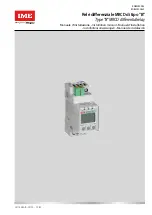
BE1-CDS220 Settings
Calculations
D-7
For wye connected CT’s:
For delta connected CT’s (See Setting Note 3)
Tap
Fault
Maximum
IE
=
Equation D-10
69 kV Side
5
.
11
79
.
2
60
1916
=
=
IE
Tap
phase
Fault
Maximum
IE
3
3
∗
=
Equation D-11
12.47 kV Side
4
.
11
79
.
5
160
10603
=
=
IE
Step 2:
The transient monitor function provides security from tripping for external through faults by
doubling the unrestrained unit pickup setting when saturation is detected. Calculate the
unrestrained pickup such that 2 times the unrestrained pickup is greater than 70% of the
maximum external through fault in times tap. This calculation assumes that the CTs
carrying the maximum fault saturates severely, yielding only 30% of the expected ratio
current. This leaves 70% of the fault current as false differential current.
02
.
4
2
5
.
11
70
.
0
=
∗
=
URO
Equation D-12
99
.
3
2
4
.
11
70
.
0
=
∗
=
URO
Equation D-13
Step 3:
Select the unrestrained pickup setting. Choose the larger of the unrestrained pickup values
calculated in Equations D-9 and D-12 or D-13, and round it up to the next integer value. (In
Equation D-12, because 4.02 is very close to 4.0, do not round up to 5.) This results in a
setting of URO = 4 times tap for this example.
Step 4:
Convert pickup setting to primary amperes.
As a reality check, convert the unrestrained pickup sensitivity to high side and low side primary amperes.
The equation to do so is similar to Equation D-8.
kV
69
@
A
670
1
60
79
.
2
4
=
∗
∗
=
Ipri
Equation D-14
kV
12.47
@
A
706
,
3
1
160
79
.
5
4
=
∗
∗
=
Ipri
Equation D-15
Calculate Slope
The percentage restrained tripping characteristic is defined by the slope ratio. The slope setting S is the
ratio of the differential current (I
op
) versus the restraint current (I
restraint
) that will cause a trip. The
percentage differential characteristic can operate on a slope setting that is a percent of the maximum of
the through currents or a percent of the average of the through currents.
Step 1:
Calculate the Operating Slope S
i
.
The operating slope S
i
is the ratio of the differential current (I
op
) caused by the sum of all the mismatch
sources versus the through current. The following sources of I
op
current must be taken into account.
•
No load tap changer (this can be compensated for in the tap calculation). You may choose to include
this source of mismatch if it is possible that the no load taps may be adjusted without the relay taps
being reset.
•
Load tap changer.
•
Tap mismatch (assumed to negligible due to the fine tap adjustment available in the relay).
Содержание BE1-CDS220
Страница 2: ......
Страница 10: ...viii Introduction BE1 CDS220 This page intentionally left blank...
Страница 36: ...ii Quick Start BE1 CDS220 This page intentionally left blank...
Страница 48: ...ii Input And Output Functions BE1 CDS220 This page intentionally left blank...
Страница 66: ...iv Protection and Control BE1 CDS220 This page intentionally left blank...
Страница 112: ...ii Metering BE1 CDS220 This page intentionally left blank...
Страница 116: ...5 4 Metering BE1 CDS220 This page intentionally left blank...
Страница 166: ...ii BESTlogic Programmable Logic BE1 CDS220 This page intentionally left blank...
Страница 176: ...7 10 BESTlogic Programmable Logic BE1 CDS220 This page intentionally left blank...
Страница 234: ...8 56 Application BE1 CDS220 This page intentionally left blank...
Страница 236: ...ii Security BE1 CDS220 This page intentionally left blank...
Страница 240: ...9 4 Security BE1 CDS220 This page intentionally left blank...
Страница 242: ...ii Human Machine Interface BE1 CDS220 This page intentionally left blank...
Страница 256: ...10 14 Human Machine Interface BE1 CDS220 This page intentionally left blank...
Страница 258: ...ii ASCII Command Interface BE1 CDS220 This page intentionally left blank...
Страница 289: ...BE1 CDS220 Installation 12 7 Figure 12 8 MX Case Horizontal Panel Mount Front View Overall Dimensions...
Страница 422: ...14 32 BESTCOMS Software BE1 CDS220 This page intentionally left blank...
Страница 424: ...ii Time Current Characteristics BE1 CDS220 This page intentionally left blank...
Страница 441: ...BE1 CDS220 Time Overcurrent Characteristic Curves A 17 Figure A 13 Time Characteristic Curve A Standard Inverse 99 1621...
Страница 442: ...A 18 Time Overcurrent Characteristic Curves BE1 CDS220 Figure A 14 Time Characteristic Curve B Very Inverse 99 1376...
Страница 443: ...BE1 CDS220 Time Overcurrent Characteristic Curves A 19 Figure A 15 Time Characteristic Curve C Extremely Inverse 99 1377...
Страница 444: ...A 20 Time Overcurrent Characteristic Curves BE1 CDS220 Figure A 16 Time Characteristic Curve G Long Time Inverse 99 1622...
Страница 452: ...ii Terminal Communication BE1 CDS220 This page intentionally left blank...
Страница 456: ...C 4 Terminal Communication BE1 CDS220 This page intentionally left blank...
Страница 458: ...ii Settings Calculations BE1 CDS220 This page intentionally left blank...
Страница 475: ......












































